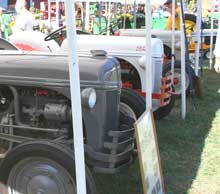Although most of my tractor time has been spent at the helm of ancient Farmalls, I’ve long had a hankering for one of the old gray friends, the N-series Fords. Built from 1939 to 1952, the little tractors were not powerful, but they were inexpensive and, most significantly, pioneered the three-point hydraulic implement hitch in the United States.
The latter was the brainchild of Irish inventor Harry Ferguson, who licensed the concept to Henry Ford with a handshake agreement. Ford’s Fordson tractor had been out of production in the US for a decade when the new machine was introduced early in 1939. Designated “9N” (9 for 1939), it was powered by a 120 cid 28 hp L-head four with full electric system and coil ignition (though tucked away inaccessibly per Henry Ford’s fetish), three-speed transmission and the Ferguson System hydraulics. For this reason they were frequently called “Ford-Fergusons.” Nearly 100,000 were built through 1942.
A number of running changes were made to 9Ns over the years, the final few of which resulted in a new model designation 2N in 1942. In addition to a three-spoke steering wheel and pressurized cooling system, the 2N was available with steel wheels and magneto ignition for wartime austerity.
Finally, for 1948 a much improved 8N bowed, with higher compression engine, four-speed transmission and refinements to the hitch hydraulics. Most obvious was the contrasting red engine and drive train, giving the 8N the nickname “redbelly.” Ford reneged on the agreement to pay royalties to Ferguson and took his name off the tractors, which resulted in a long legal skirmish. Built through 1952, the 8N was the most popular, with more than 500,000 built. Late in the run, a side-mounted distributor replaced the buried unit and a “Proof Meter,” a recording tachometer with calibration for the various gear ratios, was added.
Steve McManus has an early 8N that he bought from his brother-in-law. Equipped with the Dearborn loader and a large bush hog mower, he uses it on his Christmas tree farm and to lift and move engines. For general farm work, the Fords are a bit underpowered, and, since they lack power steering, are hard to steer, especially with a full bucket. The loader is powered by a front-mounted hydraulic pump, and its frame inhibits access to the engine and especially the distributor. Despite its drawbacks, Steve says it’s handsome and well built, and “all parts are readily available and affordable, something which cannot be said about my other obsolete tractors.”
To celebrate the company’s golden anniversary, Ford introduced the NAA “Golden Jubilee Model” in 1953. Power came from a 134 cid ohv four, making 31 hp, and a completely different hydraulic system was used to avoid infringement on Ferguson patents. In 1955, with the introduction of a larger model 800, the NAA was renamed “600.” Steve Mierz sent along some photos of his brother-in-law’s 640 series Ford, outfitted with snowplow and grader blades. It also has wheel weights and a canvas foul weather cab.
Harry Ferguson won his lawsuit against Ford, but by the time of the 1952 judgment he had long since embarked on building his own tractors, but that’s a story for another time. If you’d like to know more about these old gray friends, seek out Ford Tractors by Robert N. Pripps. It will tell you everything you want to know, except, possibly, how to read the Proof Meter.

